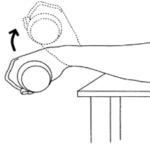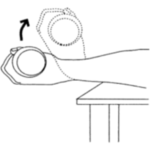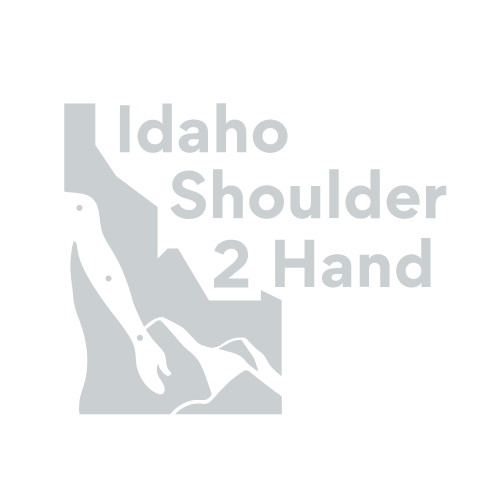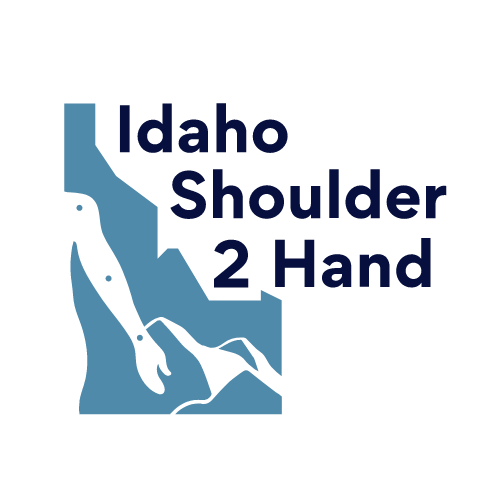Golfer’s Elbow
(Medial Epicondylosis)
Golfer’s Elbow
(Medial Epicondylosis)
Many racquet players, golfers, and people who perform repetitive grasping and gripping develop pain on the inner side of the elbow. This condition is a type of tendon degeneration called medial epicondylosis or “golfer’s elbow.” Medial epicondylosis is caused by using a repetitive strong grip while swinging a golf club, racquet, or by repetitive twisting or grasping. The condition is an overuse degenerative injury of the tendon attachment at the elbow of the wrist flexor muscles.
The flexor muscles of the forearm that flex the wrist toward the palm of the hand originate at the medial epicondyle of the elbow. Sudden strong or repetitive use of these muscles may cause injury at the point of maximum stress at the elbow attachment point.

Contributing factors
- Weak muscles
- Injury
- Overuse – playing or working excessively and excessive repetitive forceful gripping while flexing and twisting the wrist/forearm.
- Improper equipment – incorrect grip size, worn out grips, strings to tight on racquets
- Equipment/tools that are too heavy or unbalanced
- Poor playing technique – too much wrist action, jerky strokes, poor ball contact in golf
- Smoking – Smoking causes degeneration in muscle, tendon, bone, and ligament tissue
Treatment
- Rest – Stop the aggravating activity. A period of rest is absolutely imperative to allow the injured area an opportunity to heal. You will make the condition worse by continuing the activity that causes the injury, especially if there is pain associated with the activity. Avoid heavy lifting or carrying, and avoidable repetitive activities such as shaking hands and opening doors.
- Ice – Apply direct cold to your the lateral (outside) part of your elbow a minimum of 3 times per day for at least 15-20 minutes and after active use of your arm. Protect your skin by placing a towel between your elbow and the ice.
- Stretching – Stretching will help prevent stiffness and elongate muscle tissue making it a better shock absorber to dissipate the stress absorbed by the damaged tendon tissue.
- Physical Therapy – Exercise to stretch and strengthen the forearm muscles are started as the pain subsides. Building flexibility and strength in the muscles will protect the damaged tendon tissue and prevent recurrence of symptoms in the future.
- Medication – Occasionally, anti-inflammatory medications (such as aspirin, ibuprofen, naproxen) may be recommended to help reduce acute pain and inflammation. Please consult with your primary care physician before taking these medications for any duration of time.
- Injection – Corticosteroid injections, though effective in temporarily reducing pain for hours or days, is not an effective long-term solution for golfer’s elbow. It will not replace the role exercise and will not change the duration of time required for physiological healing and recovery. If you receive a cortisone injection, you should not play sports or use the arm forcefully for at least 2 weeks. Repetitive cortisone injections are likely harmful to the tendon and may worsen the tendon’s integrity.
- Brace – A wrist splint or counter-force brace (an elastic strap worn 1-2 inches below the elbow over the flexor muscles) may be recommended. A wrist splint tries to rest the flexor muscles while a counter-force brace gives compression to the forearm muscles and tries to lessen the force absorbed by the damaged tendon attachment. Initially, the brace may be worn during all waking hours. As the pain subsides, it should be used only during activities that stress the injured tendon.
- Surgery – Surgery is rarely required but may become an option for chronic or recurrent golfer’s elbow that has failed at least 3 rounds of appropriate therapeutic intervention.
Returning to sports or strenuous activity
Warm up. Always warm up before you play or engage in strenuous activity. Place all of your major joints through their range of motion and work up a “sweat” prior to starting your activity. Always stretch your muscles thoroughly before you begin and at the end of your activity.
Your Racquet. Use a lighter weight racquet and move your hand “up” on the grip. Change to a racquet that has greater spring to absorb energy. Reduce the string tension. Re-wrap the grip on the racquet. Discuss equipment changes with your local pro.
Your Tennis Stroke. Focus on your strokes and good mechanics. Engage your core to generate power. Minimize wrist flexion in the forehand stroke.
Your Golf Club: Re-wrap the grips on your club. Change to a larger club grip. Discuss equipment changes with your local pro.
Your Golf Swing: Focus on the swing technique. Use your core to optimize power. Loosen the grip on your club. Avoid the long ball and tall rough until the pain is gone. Minimize ground contact in your game.
Your Game. Start back slowly. In tennis, play short periods of time and gradually increase once the elbow pain is gone. In golf, start with putting and chip shots and slowly work up the clubs. Work from a few holes to a complete game.
After the Game. Stretch the muscles before and after you finish your activity. Apply ice to the elbow for at least 15-20 minutes.
Exercises
Exercises to stretch and strengthen the muscles attached to the injured and damaged tendon will help with the healing process. Strengthening exercises should be avoided until the stretching exercises no longer cause pain. The following exercises can be done every day until your symptoms subside. Continue to use these exercises as a warm-up prior to any strenuous gripping sport or activity. Continue to use these exercises to prevent recurrence of symptoms.
First Phase:
 WRIST EXTENSOR STRETCH: Begin with elbow straight. With other hand, grasp at thumb side of hand and bend wrist downward. To increase the stretch, bend wrist toward small finger. Hold for 20 seconds, rest for 20 seconds. Perform one set of three repetitions, twice daily.
WRIST EXTENSOR STRETCH: Begin with elbow straight. With other hand, grasp at thumb side of hand and bend wrist downward. To increase the stretch, bend wrist toward small finger. Hold for 20 seconds, rest for 20 seconds. Perform one set of three repetitions, twice daily.
 WRIST EXTENSOR STRETCH: Begin with elbow straight. With other hand, grasp at thumb side of hand and bend wrist downward. To increase the stretch, bend wrist toward small finger. Hold for 20 seconds, rest for 20 seconds. Perform one set of three repetitions, twice daily.
WRIST EXTENSOR STRETCH: Begin with elbow straight. With other hand, grasp at thumb side of hand and bend wrist downward. To increase the stretch, bend wrist toward small finger. Hold for 20 seconds, rest for 20 seconds. Perform one set of three repetitions, twice daily.
Second Phase:
 RESIST WRIST EXTENSORS WITH WEIGHT: Hold a two pound weight with hand. Place forearm on table with hand off edge of table, palm down. Move wrist upward. Return to starting position. Perform two sets of 10 repetitions, twice daily.
RESIST WRIST EXTENSORS WITH WEIGHT: Hold a two pound weight with hand. Place forearm on table with hand off edge of table, palm down. Move wrist upward. Return to starting position. Perform two sets of 10 repetitions, twice daily.
 RESIST WRIST FLEXORS WITH WEIGHT: Hold a two pound weight with hand. Place forearm on table with hand off edge of table, palm up as shown. Move wrist upward. Return to starting position. Perform two sets of 10 repetitions, twice daily.
RESIST WRIST FLEXORS WITH WEIGHT: Hold a two pound weight with hand. Place forearm on table with hand off edge of table, palm up as shown. Move wrist upward. Return to starting position. Perform two sets of 10 repetitions, twice daily.

